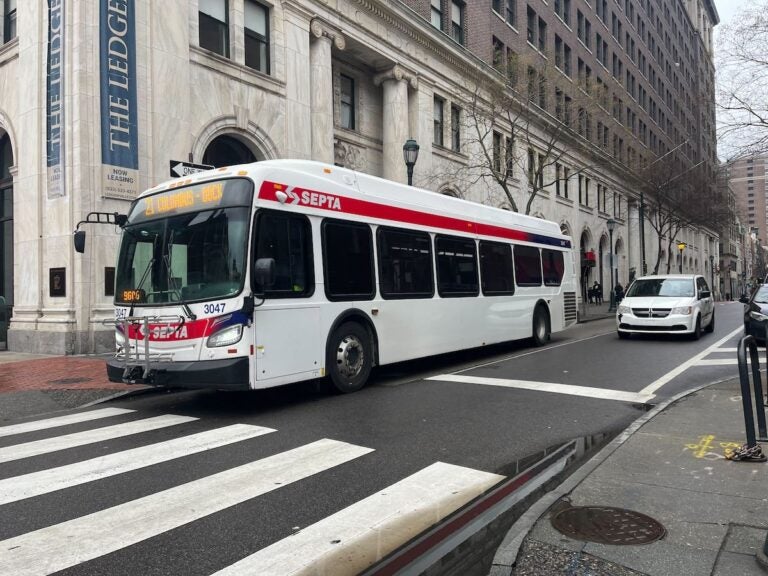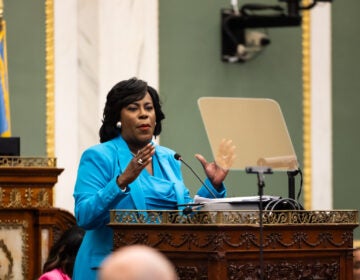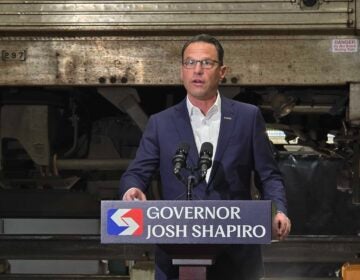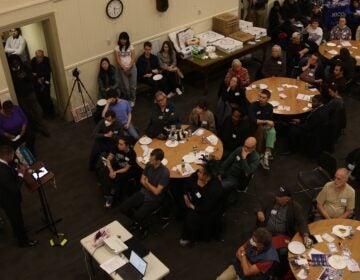Why has SEPTA once again delayed its bus revolution?
After two years of public comment, SEPTA’s bus-route overhaul is yet again back to the public for further comment before being approved for implementation.

SEPTA has identified a shift from Center City Service to Market Street/JFK Boulevard as a possible Bus Revolution improvement to Route 21, which carried nearly 10,000-weekday riders pre-COVID-19. (Owen Racer/WHYY)
Have a question about Philly’s neighborhoods or the systems that shape them? PlanPhilly reporters want to hear from you! Ask us a question or send us a story idea you think we should cover.
Two years of public comment wasn’t enough.
In conjunction with City Council this month, SEPTA further delayed its bus-route overhaul known as “Bus Revolution” to seek further public comment. It is currently unclear where and when they will hear more comments before the next board vote, which is also yet to be scheduled.
If approved, “Bus Revolution” won’t see implementation until 2025, according to SEPTA spokesperson Andrew Busch, who says it remains unknown whether the new round of public comment will bring additional changes resulting in further delay. The latest delay came at City Council members’ request for more time to engage with constituents.
“I don’t think there’s much that will be learned that hasn’t been already shared at these different community meetings,” said Tariem Burroughs, chairperson of the independent SEPTA Citizen Advisory Committee.
According to Burroughs, excessive community engagement can be counterproductive. He notes that protracted delays in implementing improvements can lead to increased costs and negatively affect ridership, which is a crucial concern given the scarcity of meaningful public input in SEPTA’s decision-making process.
“Though you’re new council members, you were still in the city when this was all going on,” Burroughs said. “If you wanted to be in control of your constituents maybe you should have been there with your future constituents at those meetings.”
Inequities arose in the accessibility of the previous 200 public meetings, with some riders unaware of their existence or unable to access them, according to rider advocate groups. SEPTA asserts they will provide ample notice for riders to participate in upcoming public comment sessions. Busch stated that as of February, SEPTA remains uncertain whether these additional meetings will offer the option for virtual attendance.
Due to the cost-neutral nature of the bus revolution, meaning some riders and routes will benefit at the expense of others, everyone can’t win, according to Transit Forward Philadelphia’s Connor Descheemaker. This give-and-take concerns rider advocates, who say riders with disabilities are not set to benefit much from the overhaul.
The plan proposes to discontinue many routes, including 1, 8, 30, 32, 35, 47M, 50, 62, 73, 78, 80, 89, 90, 91, 92, 103, 106, 111, 120, 123, 128, 132, 133, 139, 150, 201, 204, 206, 311, G, H, J, K, L, R, and route XH. However, some are recommended to be renamed or rerouted. However, due to funding constraints and a shortage of operators, the bus network has undergone unintended alterations, culminating in an existing service reduction of nearly 20%. This predicament has led to the formulation of the proposed cost-neutral plan.
“For every hour of service, every dollar of service you’re going to spend somewhere else you’re going to take a dollar of an hour of service from another route,” said Will Tung of the urbanist political action committee 5th Square.
As an example, “Bus Revolution” could make bus arrivals more frequent and reliable by following more direct routes, as the plan proposes. However, this leaves some riders with a disability at a disadvantage, as these proposed changes would require them to have to travel longer distances to reach their bus stop.
“Even though the bus is coming sooner, you still have to get there,” said Latoya Maddox, Chairperson of SEPTA’s independent Advisory Committee for Accessible Transportation.
Maddox has noticed accessibility has increasingly been left out of diversity, equity and inclusion efforts, as seen in Philadelphia’s deaf, hard-of-hearing, and non-English speaking communities, who aren’t currently set to see many improvements in bus accessibility, aside from potential expanded language access. Maddox says riders with disabilities are concerned that American Sign Language is not currently in the plans.
SEPTA hopes “Bus Revolution” will address the system’s decline in ridership, increase reliability and speeds, and expand routes to non-peak hours. However, a part of this plan will funnel more routes to connections along the system’s main two lines, Market-Frankford and Broad Street. Rider advocates say this fundamental approach redirects riders from their most efficient route and further inconveniences riders with disabilities.
Safety concerns have also been raised over the two years of comment, which SEPTA hopes to address through increased law enforcement presence but primarily only on the two main subway lines, where bus riders are set to be increasingly brought.
The delayed plan comes at a time when SEPTA’s bus ridership is a matter of survival, says Steph Davis of the urbanist group 5th Square. Tung sees SEPTA’s bus network situation in a “ridership death spiral.”
“We still have a lot more to find out,” SEPTA spokesperson Busch said. “It’s a lot of listening on our part.”

Subscribe to PlanPhilly
WHYY is your source for fact-based, in-depth journalism and information. As a nonprofit organization, we rely on financial support from readers like you. Please give today.







